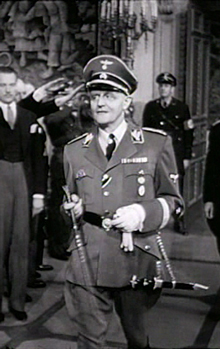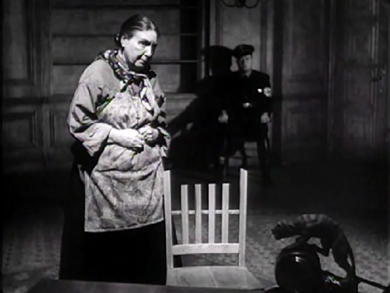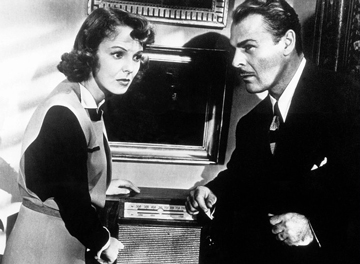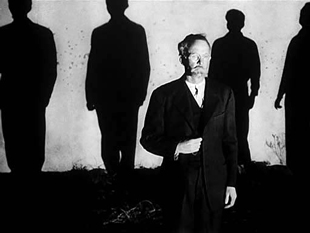
 |
|
|
|
A major restoration! Too many good movies aren't available in good viewing condition, so we need to be grateful when an important at-risk title jumps back from the edge of extinction. I've had a fine time for the last twenty years following the fate of Fritz Lang's superb wartime propaganda thriller Hangmen Also Die! A DVD was released by Kino in the late '90s, using the best materials then available; it didn't look particularly good and sounded worse. It also had a frustrating jump cut where an important missing scene should have been. Lotte Eisner detailed the cut, which identified Hangmen as yet another Fritz Lang film in need of serious restoration. Four years ago I was lucky to be sent an OOP German Hangmen DVD. Mastered in the PAL format, it ran at an annoying 25 frames per second. But the image was improved and the restored ending provided a satisfying finish. We can theorize reasons why that final scene might have been removed, but they'd still be guesses. We don't even know when it was taken out. The Cohen Collection has finally brought out its Blu-ray cut of Fritz Lang's movie, restored in England by the BFI and Pinewood Studios. The show is now uncut and in fine condition throughout. My second DVD review of Hangmen already has comprehensive coverage of the movie and a full run-down on the quality of Cohen Media's new Blu-ray can be found further down the page. The following essay concentrates on the film's thorny political aspect. 
Hangmen Also Die! is as tightly plotted as any of Fritz Lang's Dr. Mabuse films. The Reichsprotektor of occupied Czechoslovakia, 'Hangman' Reinhard Heydrich (Hans von Twardowsky of The Cabinet of Dr. Caligari) is gunned down on a side street in Prague. To avoid capture, assassin Dr. Swoboda (Brian Donlevy) is forced to involve a witness, Mascha Novotny (Anna Lee) and her professor father (Walter Brennan). Heydrich dies, and in the Nazi reprisals that follow, a traitorous double agent among Swoboda's Communist comrades, Emil Czaka (Gene Lockhart) helps the Gestapo bloodhound Alois Gruber (Alexander Granach) compile a list of civilian hostages. Rounded up by the hundreds, the partisans are to be systematically shot until the assassin is turned in to the authorities. The Czech people instead rally against the threat. Swoboda's comrades insist that he not to give himself up, and average citizens refuse to betray him. To fool the police, Mascha must pretend to be Swoboda's lover, destroying her relationship with her fiancé (Dennis O'Keefe). As a hostage prisoner facing the possibility of execution at a moment's notice, Mascha's father rediscovers his political identity. Just when Swoboda's betrayal is imminent, his surviving comrades put a desperate plan into effect... This is one daring movie, made by Germans forced from their homeland by the Nazi regime. Nobody knew the details of the assassination of Heydrich in Prague, so Fritz Lang cooked up an elaborate fictional version to serve as a primer on Gestapo tactics and life under Nazi occupation. Lang's co-writer Bertolt Brecht was an acknowledged theater genius, a very left-wing German who Lang had helped emigrate from Sweden to avoid the long arm of the Nazis. Brecht's previous movie was the pro-Communist Kuhle Wampe, or Who Owns the World? It was barely finished before the Nazis came to power and put it off-limits. Brecht wanted Lang's news anti-Nazi movie to be pro-Communist. Its proposed title was "437!", which corresponded to the number of Czechs executed by the Nazis immediately after the assassination. Brecht thought of everything in radical-theater terms, with the extras forming an ideological chorus to communicate a political message. Lang of course wanted a tense, claustrophobic thriller to dramatize Nazi horrors and to help publicize the sacrifice of the Czech resistance. There was nothing subversive about this. The War Office wanted to promote the Soviets as our allies. It can be assumed that they didn't want to publicize the fact that the core resistance in occupied countries was indeed Communist. Since Brecht knew almost no English, left-wing Hollywood writer John Wexley (Confessions of a Nazi Spy, The Last Mile) collaborated on the screenplay as well. Lang got the script he wanted, but long after Brecht had walked off the movie, with recriminations all around. Brecht was disgusted with Lang's insistence on things like a romantic interest -- or really anything that got in the way of a radical political theater piece. Brecht knew nothing of American movies and didn't care. As far as he was concerned Lang (who was himself no slouch in the big ego department) was crushing the artistic will of a bona fide genius. The fact that Lang had saved Brecht's neck from the Nazis apparently didn't figure in. 
One of the most exciting things about Hangmen Also Die! now is how daring it is as Nazi-hating propaganda. Hollywood produced a surfeit of anti-Axis dramas in 1942, including many anti-Japanese pictures packed with racial slurs and distortions. But it can be argued that Lang's film is the strongest and most compelling anti-Berlin picture of the war. Although promoted as 'the secret story of the killing of Heydrich', Hangmen is a complete fabrication, a thriller every bit as confected as Lang's fantastic spy show Spione. The wicked fun begins with a great smear job on The Reichsprotektor. A handsome and poised bureaucrat, Heydrich was the brains behind the infamous Wannsee Conference. Hangmen ignores the truth. We instead see a swishy homosexual (read: degenerate) who sashays arrogantly into a meeting hall wearing lipstick, no less. He flashes perverted smiles, and then explodes in furious shouting when somebody dares to speak in the 'filthy' Czech language. A second high-ranking Nazi is given rude blemishes on his face, large pustules that even stand out in B&W. He even worries one in a mirror. Are we supposed to conclude that he's syphilitic? He could be the model for "Fearless Leader" in the later cartoon show Rocky and Bullwinkle. 2 Skipping standard scenes of torture, Lang instead chooses to let us make our own inferences from shots of jackboots, prison bars and whips as shadows on a polished floor. Rather than be tortured and reveal the identities of his comrades, a prisoner throws himself through a high window. The idea of torture is conveyed best when a sadistic Nazi forces an arthritic old woman to repeatedly pick up a piece of a broken chair, just to watch her suffer. 
But Lang doesn't make his Nazis into fools. Alexander Granach's brilliant and efficient Gestapo investigator Gruber sets out like a bloodhound to find the assassin. The tenacious Gruber easily manipulates the Czech Quisling Czaka, and eventually figures out the entire conspiracy. He's the smartest character in the movie. According to Brecht's journals, he and Lang apparently clashed strongly on the makeup of the hundreds of Czech hostages rounded up to be. Brecht wanted them to be a workingman's chorus, to insinuate that wealthy Czechs were anti-Semitic and would collaborate with the Nazis. Lang kept things simple, i.e., he focused on the 'hate Nazis' issue. The hostages represented a cross-section of Czech society, with rich men, intellectuals, teachers (like Professor Novotny) and poets in the mix. Hangmen retains Brecht's a rather patronizing scene in which a famous poet praises a more humble prisoner's patriotic song of defiance. The hostages express complete solidarity and are willing to become martyrs. Their somewhat forced speeches dream about a 'perfect society' to come, which certainly sounds like a Soviet-style people's republic. But Lang still identifies them as patriots, not Communists. It may be cynical to bring it up, but the notion of solidarity in the resistance is an optimistic fantasy. Betrayal by informers and infiltrators was the norm. The incredibly complex ruse played on the Gestapo is marvelously entertaining, but even more fantastic. But such a tall tale was necessary to give the story a sentimental and hopeful finish. Hangmen Also Die! is true to the spirit of resistance, whereas the awful truth is represented better by a movie like Army of Shadows. 3 Speaking of leftist comradeship, Bertolt Brecht never made another movie and reportedly bad-mouthed Lang for the rest of his days. Co-writer John Wesley took the film to arbitration with the Screen Actors' Guild and won for himself a sole screenwriting credit. This irony doesn't speak well for the ideological solidarity of left-wing artists -- where show biz is concerned, they're as ungrateful and vicious as anybody. 
As might seem obvious, Hangmen Also Die! figures strongly in the postwar HUAC years, when anyone associated with anti-fascist activism in public or in films came under suspicion. Lang was foreign and sometimes made movies about social issues, which put a shadow over his Hollywood career. The film's composer Hanns Eisler was later branded as an unfriendly witness and deported as a political undesirable. His brother was Gerhart Eisler was a career German Communist listed as the Number One Red in America. In 1951's I Was a Communist for the FBI, actor Konstantin Shayne portrays Gerhardt Eisler as an evil, hypocritical Red committed to the overthrow of our government. From all this we have to conclude that Fritz Lang was lucky to have escaped with any kind of career. That, and it explains why otherwise decent Hollywood people named names and denounced their friends when the witch hunters came to call. Final irony: Hanns Eisler was nominated for an Oscar for his score for Hangmen. Be reminded that this political context is all back story. Lang's movie plays as a superbly structured and exciting conspiracy thriller.
The Cohen Media Group's Blu-ray of Hangmen Also Die! is an excellent restoration and encoding in all respects. We're told that the BFI and the restoration people at Pinewood accessed more than one 35mm source, and that the original negative was not complete. We do notice some quality shifting, and a few frames are missing here and there. But most of the show is detailed and sharp, and very steady within the frame. Scratches have been all but eliminated. James Wong Howe's brilliant cinematography is now well represented. The soundtrack has also been optimized and needs make no apologies. Hanns Eisler's dynamic score comes through clearly. The restored final scene is a good match for the film around it, and puts a proper coda on the story of the hostages. Although Lang simplified the politics of the occupation of Czechoslavakia, he kept Hangmen Also Die! from further Hollywood-ization. There are really no daring rescues for the prisoners and no love-conquers-all romance. There are also no payback scenes where Nazi villains get their just desserts on screen. Even though Lang's film is a suspense thriller, with its deleted scene restored it remains respectful of the memory of the many Czech patriots that died under Nazi rule. 
The extras begin with an informative feature commentary by Richard Peña, who we last heard on Cohen's new Blu-ray of Queen Margot. Peña relates some of the story of the Lang versus Brecht dust-up. He identifies as a weakness the fact that the Czechs talk with various American accents, for instance, Lionel Stander's Brooklyn accent. He may be amusing now but the accents are no different than the signs we see written in English. As late as the 1960s few Hollywood movies worried about such distinctions. Lang wanted the American audience to identify with the Czech characters, and to that end cast the film's German roles with real expatriate Germans, and the Czechs with Hollywood actors. Peña rightly notes that Lang can be too emphatic establishing essential plot points. The fact that 'architect' Swoboda seems to know a lot about medicine is reinforced multiple times. Yet Lang was again trying to make his movie communicate to every member of the audience. In the interest of total clarity he backs away from audio-video experiments and clever editorial tricks. German Professor Peter Ellenbruch is on-camera to lecture about Hangmen Also Die!'s position as a propaganda film, and to contrast its invented story with the real facts around the Heydrich assassination. Ellenbruch's speech is illustrated with a few excellent photos, but uses out-of-context newsreel footage to try to illustrate the daring mission of the Czech assassins. The newsreel footage comes from a full Ufa Nazi Newsreel, another extra. We see the elaborate funeral ceremonies mourning the murdered Heydrich, and also a report on German victories on the Eastern front. The newsreel audio (not subtitled) is rather rough, so much so that it took a minute to realize that its narration is in Castilian Spanish - this copy was an export to Franco's fascist Spain. 
Cohen's new promo trailer for Hangmen is included, along with a restoration demonstration. The comparison doesn't seem fair, as the 'before' example is timed with the contrast set to a low extreme. Of course it's going to look terrible. This restored disc of Fritz Lang's Hangmen Also Die! is near the top of notable Blu-ray releases for 2014. First the miracle of Metropolis and now this -- I only wish it were possible to recover a longer version of Lang's Cloak and Dagger.
On a scale of Excellent, Good, Fair, and Poor,
Hangmen Also Die! Blu-ray Footnotes:
1.
2. Even in a kid's cartoon, a Nazi stereotype serves as a Commie stereotype, with barely a change of costuming. Were the Jay Ward writers and artists doing their own commentary on the Cold War?
3. The true story of the assassination of Heydrich is appalling. The brave Czech assassins bungled the hit, and Heydrich almost escaped; only by a fluke did a grenade fragment happen to give him a painful, slow death (sounds good to me). The Nazis started executing hostages almost immediately. They then carried out the punitive liquidation of an entire village called Lidice, whose inhabitants had no connection to resistance activity. According to Peter Ellenbruch, the actual assassins were betrayed by one of their own. The Nazis induced a boy in the one of the safe houses to talk in a way that can still generate nightmares. 4. The horror at Lidice became a major issue in the awareness of Nazi war crimes. The Silent Village is a chilling 1943 English propaganda documentary in which a mining town in Wales expresses solidarity with Lidice. The idea is that, had Germany had successfully invaded England, massacres could have occurred there as well.

The version of this review on the Savant main site has additional images, footnotes and credits information, and may be updated and annotated with reader input and graphics.
Review Staff | About DVD Talk | Newsletter Subscribe | Join DVD Talk Forum |
| ||||||||||||||||||